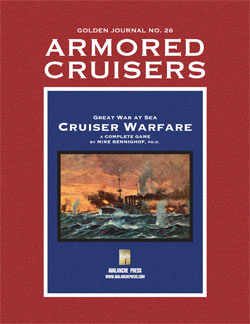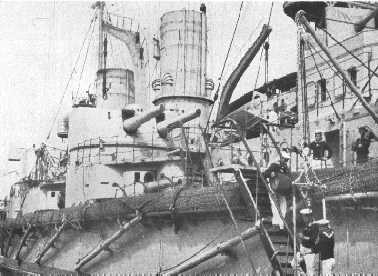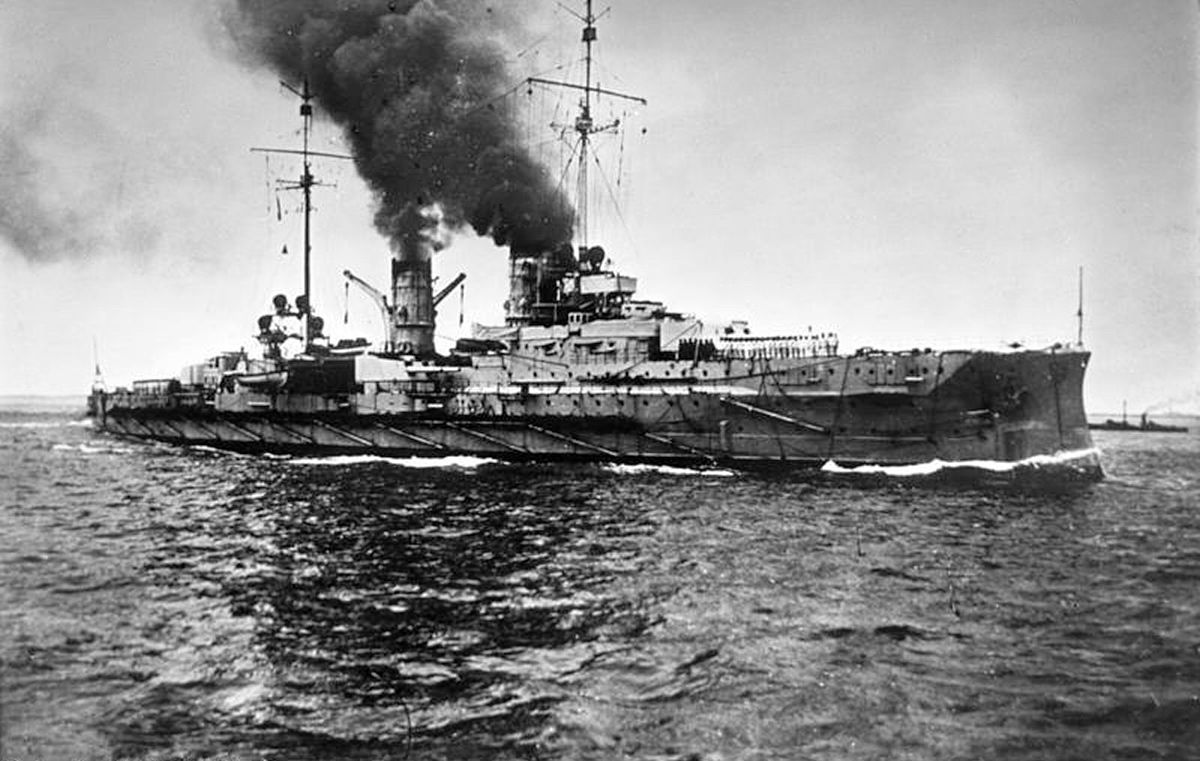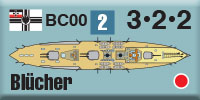Re-Designing Blücher
by Mike Bennighof, Ph.D.
December 2021
 While the German armored cruiser Blücher represented the finest ship of her type ever constructed, by the time she joined the High Seas Fleet her type had been made hopelessly obsolete by the appearance of the British battle cruiser Invincible. Invincible carried eight 12-inch guns compared to the twelve 8.2-inch guns of Blücher. The German 8.2-inch (210mm) 45-caliber newly introduced with Blücher was an exceedingly fine weapon that nearly equaled the range of the bigger British gun, but the British weapon flung a shell nearly four times as heavy. While the German armored cruiser Blücher represented the finest ship of her type ever constructed, by the time she joined the High Seas Fleet her type had been made hopelessly obsolete by the appearance of the British battle cruiser Invincible. Invincible carried eight 12-inch guns compared to the twelve 8.2-inch guns of Blücher. The German 8.2-inch (210mm) 45-caliber newly introduced with Blücher was an exceedingly fine weapon that nearly equaled the range of the bigger British gun, but the British weapon flung a shell nearly four times as heavy.
Once the German naval command realized that their new ship was now hopelessly outgunned by the new British warships, a scramble began to re-work the design to carry the German equivalent of the British weapon, the 11-inch (280mm) 45-caliber.
Blücher carried her main guns in a “hexagonal” arrangement of six twin turrets: one each fore and aft, and four in “wing” positions, two on either side. The six turrets had only four magazines: the two forward “wing” turrets received their ammunition via a pair of conveyor belts leading from the aft wing turret’s magazines. Worse, the conveyors had only minimal armor protection compared to the magazines themselves.
With the ship’s construction already well-advanced by the time details of Invincible became known, the architects had only limited options for up-gunning the cruiser. The obvious answer would be replacing the twin 210mm turrets with single mounts for the 280mm gun. That would give the ship a main armament of six heavy guns, compared to eight for Invincible, and in a less satisfactory arrangement with only four able to fire on either broadside compared to six (and theoretically eight) for the British ship.
 That placement quickly ran into problems: the conveyor-belt scheme would not work for the 280mm round, as it weighed almost three times what the 210mm rounds did. A traditional barbette and magazine could not be emplaced for the forward wing turrets, as the internal space was required for the cruiser’s old-style triple-expansion engines. Also, a serious consideration for the architects, the 150mm secondary gun emplacements directly below the wing turrets would have to be removed as well. That placement quickly ran into problems: the conveyor-belt scheme would not work for the 280mm round, as it weighed almost three times what the 210mm rounds did. A traditional barbette and magazine could not be emplaced for the forward wing turrets, as the internal space was required for the cruiser’s old-style triple-expansion engines. Also, a serious consideration for the architects, the 150mm secondary gun emplacements directly below the wing turrets would have to be removed as well.
A ship with four 280mm guns, firing only three of them on a broadside, was not acceptable. At that point, the consideration appears to have stopped. Blücher would be completed with her original outfit of twelve 210mm guns, and immediately went into service as a gunnery training ship rather than as a front-line unit. She would operate with the battle cruisers at Dogger Bank and meet her end there not because of her lightweight armament (the earlier British battle cruisers were still vulnerable to Blücher’s main armament) but due to the weakly-armored conveyor system.
A more radical reconstruction remained possible, but Alfred von Tirpitz and his admirals did not wish to delay construction any longer than necessary. They shifted their attention to the next ship, the battle cruiser von der Tann, built from the start with four twin 280mm turrets, powered by turbines and armored against heavy shellfire: a far better fighting ship than Invincible.
Blücher was the most expensive warship ever built in Germany at the time she began construction (a record that fell very quickly); in hindsight, the German Admiralty made a serious error in rushing her to completion as designed. She was built in Kiel’s Imperial Dockyard rather than at a private shipyard, which mitigated the impact of cost overruns and the pressure to clear the slipway for a new, profitable project (the dreadnought Kaiser would take her place on the stocks after Blücher’s launch).

Her narrow hull-form forward would limit her to a single-mount 280mm turret in the “A” position, atop the same armored barbette that had supported the twin 210mm turret there. But that was not the case aft, where the same twin 280mm turret and barbette could be fitted in the available space. This would be far more costly and time-consuming, as the 210mm barbette would have to be replaced, but the space existed.
Likewise, the two barbettes for turrets “C” and “E” (the aft wing positions – German practiced labelled the turrets in a hexagonal layout clockwise from the forward turret “A”) could have been removed and replaced with a single dual 280mm barbette and turret on the centerline. Blücher’s boiler rooms were located between the two pairs of wing turrets, with the engine rooms between the aft wing turrets and the aft centerline turret. The new barbette wouldn’t interfere with this arrangement, though the steam pipes which ran through the narrow space between the 210mm barbettes would have to be routed around the outside of the new 280mm structure.
The re-designed ship would have a main armament of five 280mm guns, all of them usable on either broadside, and would be able to keep all eight of her casemate-mounted 150mm guns. Since no single mount for the 280mm gun was developed, it’s difficult to estimate the difference in weight, but if it weighed in roughly the same as the twin 210mm mount then the ship would lose about 120 tons in the trade of five 210mm turrets for two with 280mm guns (assumed to be the same LC/1907 mounts fitted to von der Tann). Therefore she should have been able to maintain her top speed of 25.4 knots despite the heavier armament.
The biggest delay – and therefore cost – would come from the need to design and build a new single mount for the 280mm gun. That could of course have been done by Krupp, who designed the Imperial Navy’s main armament fittings as well as the guns themselves, at a premium cost for rush service. While the new turret was drafted, tested and built the ship would sit on the stocks waiting for them, and the new dreadnought waiting to take her place there would likewise face delay.
Blücher as re-designed would remain armored only against her old armament (or the British equivalent, the crapulent 9.2-inch Mark XI). Unlike von der Tann, she could not stand up to British 12-inch shells and would be shredded in an engagement with a similarly-armed foe. This was also true for Invincible, which could withstand Blücher’s 210mm guns but not those of von der Tann, but it went against a strongly-held principle of German warship design: a warship’s armor must be proof against her own armament.
 While the re-designed ship would have significant advantages over Blücher’s original form, she would be a very weak fighting unit compared to von der Tann and little more capable of standing alongside the later German battle cruisers than the armored cruiser version. The best choice for the German Admiralty would have been to scrap Blücher on the stocks and built a second von der Tann in her place, but that was not a realistic option in Imperial Germany’s political environment, as it would re-open the question of funding the ship at all and imperil future construction. While the re-designed ship would have significant advantages over Blücher’s original form, she would be a very weak fighting unit compared to von der Tann and little more capable of standing alongside the later German battle cruisers than the armored cruiser version. The best choice for the German Admiralty would have been to scrap Blücher on the stocks and built a second von der Tann in her place, but that was not a realistic option in Imperial Germany’s political environment, as it would re-open the question of funding the ship at all and imperil future construction.
We have a very fine die-cut, silky-smooth playing piece for the re-designed Blücher in our Golden Journal Number 26, along with scenarios so you can use her in Great War at Sea games.
Join the Gold Club to order Golden Journal No. 26: Armored Cruisers.
Click here to join the Gold Club right now!
Sign up for our newsletter right here. Your info will never be sold or transferred; we'll just use it to update you on new games and new offers.
Mike Bennighof is president of Avalanche Press and holds a doctorate in history from Emory University. A Fulbright Scholar and NASA Journalist in Space finalist, he has published a great many books, games and articles on historical subjects; people are saying that some of them are actually good.
He lives in Birmingham, Alabama with his wife, three children, and his Iron Dog, Leopold.
Want to keep Daily Content free of third-party ads? You can send us some love (and cash) through this link right here.
|
